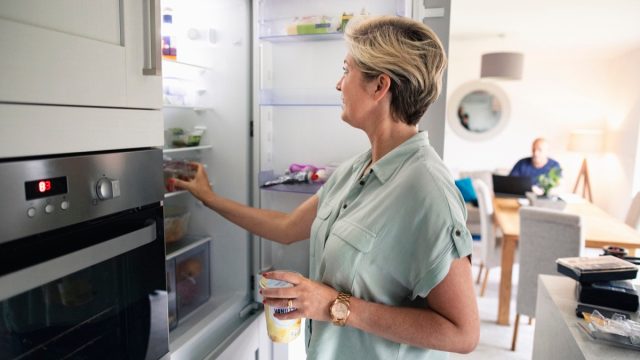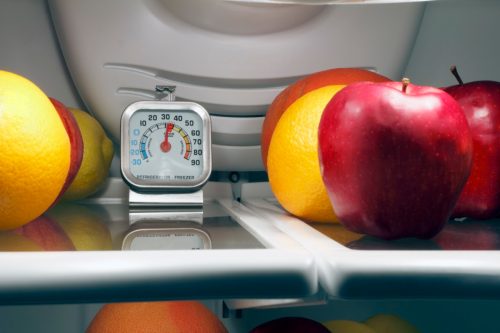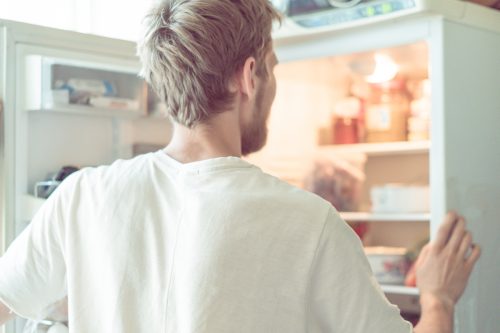If You Notice This in Your Fridge, Throw Out Your Leftovers, Experts Warn
This is a major sign that your leftovers may not be safe to eat.

Most people's refrigerators have seen their fair share of leftovers. Leftovers can serve as a quick and easy meal, not to mention significantly reducing food waste—that is, if you get to eating them instead of letting them waste away in your fridge. But are all leftovers safe to eat? Experts say there's one thing you should check in your fridge before warming up last night's meal that will let you know if you can safely eat it or should throw it away. Read on to discover a major sign you should toss your leftovers.
RELATED: Never Eat Microwaved Food Before Doing This, FDA Warns.
If your fridge temperature is higher than 40 degrees Fahrenheit, throw away your leftovers.

Your leftovers should be left in a refrigerator that is 40 degrees Fahrenheit or lower for them to be safe enough for you to reheat and eat. "The key to safely reheating food is to ensure it was cooled and stored properly prior to reheating," explains Alexis Martinez, a nutrition coach and founder of the nutrition and wellness website Healthy Brown Girl.
According to Lisa Richards, a nutritionist and author of The Candida Diet, this is because most microbes and pathogens that cause foodborne illnesses end up present in certain foods due to improper cooling or handling. The U.S. Food and Drug Administration (FDA) says that Listeria, one type of bacteria that causes these illnesses, is particularly prone to growing in refrigerators where the temperature is above 40 degrees Fahrenheit.
Martinez says pathogens are most likely to grow when food is between 70 and 125 degrees Fahrenheit. "As a general rule it is best to reheat all food to 165 degrees Fahrenheit throughout and allow it to have been at that temperature for at least 15 seconds," Richards notes.
You can check your refrigerator temperature with an appliance thermometer.

The FDA says you should be keeping your refrigerator temperature at or below 40 degrees Fahrenheit and checking the temperature periodically. According to the agency, you can check your refrigerator temperature by using an appliance thermometer. "Appliance thermometers are the best way of knowing these temperatures and are generally inexpensive," the FDA states on its website.
The U.S. Department of Agriculture (USDA) says that appliance thermometers should still be able to indicate the temperature in your fridge, even if your power is out. "If you're not sure a particular food is cold enough, take its temperature with a food thermometer," the USDA advises. As long as it reads below 40 degrees Fahrenheit as well, the food should be safe enough to refreeze or reheat.
RELATED: For more food safety advice delivered straight to your inbox, sign up for our daily newsletter.
You could end up hospitalized if you eat food contaminated with Listeria.

Listeria is the one of the biggest bacteria risks possible with refrigerated leftovers. "Unlike most bacteria, Listeria germs can grow and spread in the refrigerator," the FDA warns. "The germs not only multiply at the cool temperature, they could contaminate your refrigerator and spread to other foods there, increasing the likelihood that you and your family will become sick."
Unfortunately, this bacteria is also one of the most dangerous, as eating food contaminated with Listeria can make you so sick that you have to be hospitalized. Certain people, like pregnant women, older adults, and immunocompromised individuals, are even more at risk for listeriosis—the illness cause by Listeria—and getting infected can be fatal for them. According to the FDA, listeriosis has a high mortality rate of 20 to 30 percent, with more than 90 percent of people who develop the illness needing to be hospitalized.
Listeriosis can cause a variety of symptoms depending on who is infected and where in the body the bacteria has invaded. Some common symptoms include fever, muscle aches, severe headache, nausea, vomiting, stiff neck, confusion, loss of balance, and convulsion, per the FDA. If you're pregnant, you're not likely to have gastrointestinal symptoms, and your only sign of listeriosis might be fever.
You should never eat leftovers than have been left in your fridge for more than four days either.

Your fridge temperature is not the only safety indicator for leftovers. No matter the temperature, most leftovers are only safe in your refrigerator for three to four days. "Leftover cooked food may be stored in the refrigerator for up to three to four days. During this time, you can reheat the leftovers to 165 degrees Fahrenheit," the USDA explains.
The only exception to this rule is if you have already reheated them. According to the USDA, you can extend the life of your leftovers by reheating them before the four days are up. "After each reheating, leftovers will be safe in the fridge for an additional three to four days," the agency says. But the quality of your food will decrease every time it is reheated, so the USDA advises that you reheat only the amount needed each time.
"Cooked foods that cannot be used within four days should be frozen for longer, safe storage," the agency states. "Leftovers are safe in the freezer indefinitely, but they are at best quality for a few months."





















